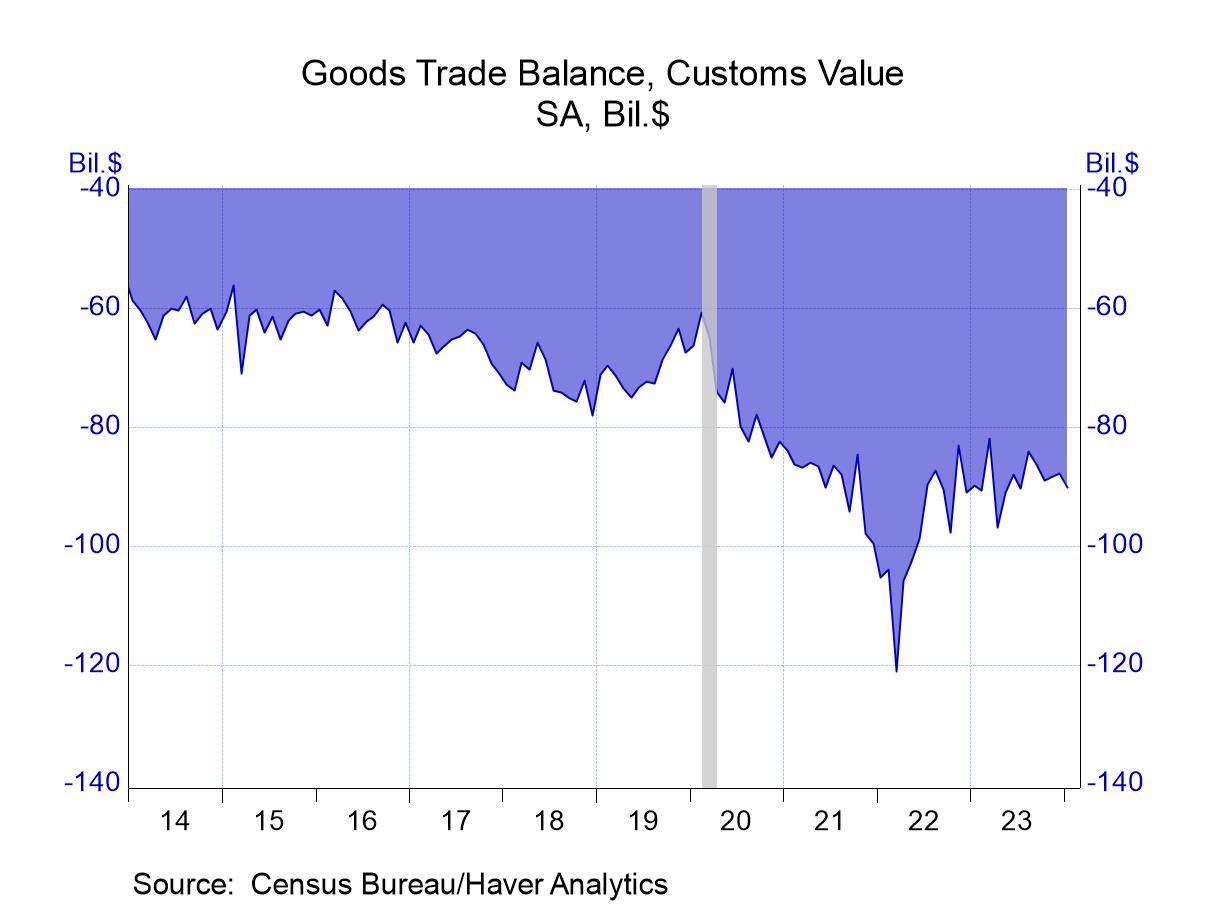U.S. Foreign Goods Trade Deficit Widens Slightly in January
Summary
- $90.2 billion deficit modestly wider than expected.
- Exports rise 0.2%, led by shipments of automotive goods.
- Imports increase 1.1%, with autos and associated goods up 5.1%.


The advance estimate of U.S. international trade widened modestly in January to -$90.2 billion from $87.9 billion in December. These “advance” estimates are not revised with releases of later foreign trade detail. The Action Economics Forecast Survey had expected a January deficit of -$88.8 billion.
Exports of goods in January increased 0.2% from December (-2.9% y/y) following a 2.5% increase in December. Exports of autos and associated goods had the biggest increase in January, 10.3% (-2.8% y/y), more than reversing a 3.2% decrease in December. Consumer goods exports other than autos rose 2.6% (-5.5% y/y) in January after a 4.3% increase in December, and capital goods exports were up 1.4% (+2.1% y/y) in January after decreasing modestly by 0.5% in December. Exports of other items decreased last month, most notably “other goods” -6.0% (+4.7% y/y) after a 5.6% increase in December. Industrial supplies exports fell 2.1% (-3.2% y/y) after a sizable 5.8% increase in December. Exports of foods, feeds & beverages were down 1.9% in January (-7.4% y/y), partially reversing a 5.1% gain in December.
Imports of goods rose 1.1% in January, although the y/y change was -1.8%; December’s goods imports had increased 1.5%. Among import categories, the largest monthly increase was in automotive vehicles and associated goods, up 5.1% (+6.6% y/y), more than reversing a 1.1% decrease in December. Capital goods imports rose 4.2% in January (+3.0% y/y) after decreasing 1.4% in December. “Other goods” imports were up 3.2% in January (+5.8% y/y), after increasing just 0.2% in December. Imports of foods, feeds & beverages edged up 0.2% in January (-3.0% y/y), following a modest 0.3% decrease in December. Two categories saw declines in imports in January. Industrial supplies imports decreased 2.7% (-2.4% y/y) after a 2.0% increase in December, and consumer goods imports fell 2.3% in January (-7.6% y/y), following a 5.5% rise in December.
The advance international trade data can be found in Haver's USECON database. The expectations figure is from the Action Economics Forecast Survey, which is in AS1REPNA.
Carol Stone, CBE
AuthorMore in Author Profile »Carol Stone, CBE came to Haver Analytics in 2003 following more than 35 years as a financial market economist at major Wall Street financial institutions, most especially Merrill Lynch and Nomura Securities. She has broad experience in analysis and forecasting of flow-of-funds accounts, the federal budget and Federal Reserve operations. At Nomura Securites, among other duties, she developed various indicator forecasting tools and edited a daily global publication produced in London and New York for readers in Tokyo. At Haver Analytics, Carol is a member of the Research Department, aiding database managers with research and documentation efforts, as well as posting commentary on select economic reports. In addition, she conducts Ways-of-the-World, a blog on economic issues for an Episcopal-Church-affiliated website, The Geranium Farm. During her career, Carol served as an officer of the Money Marketeers and the Downtown Economists Club. She has a PhD from NYU's Stern School of Business. She lives in Brooklyn, New York, and has a weekend home on Long Island.





